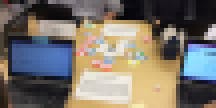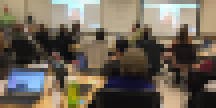What does it mean to truly collaborate? For a group of teachers at my district last spring, it meant stepping outside their own roles and trying on someone else’s point of view.
Collaboration can be a great tool to help solve pressing challenges, but when everyone thinks alike its impact is limited. To understand true collaboration, and seek solutions that benefit everyone, it helps to put yourself into the minds of your audience. When you think like a parent or student, new perspectives and ideas have a way of jumping out. It’s not always easy, but by working together through a process known as foresight gaming, or 21st century strategy simulation, educators, statesmen and even ordinary citizens have found creative answers to complex problems.
It may help to think of strategy simulation like a role-playing game where each participant must wear many hats. To play, individuals are given scenarios and use card prompts to start conversations around tough challenges with the aim of inventing solutions that benefit everyone. The futurist John Sweeney has used this tool all over the world with governments and organizations to promote foresight and planning for the future.
A few years ago the United Nations commissioned Sweeney to bring the simulation to Tonga, a small kingdom in the South Pacific, as a way to help the country strategize for the future. Around 100 ordinary citizens were given scenarios, such as the future of the country’s water system, and then asked to rearrange cards to guide discussions and find solutions.
For the exercise, the cards were broken up into categories—health, resource scarcity, extreme weather—which served to help participants make connections between topics and indicate priorities. By examining where and how participants placed their cards, along with their verbal explanations, Sweeney and a team of futurists were able to analyze the results and come up with a “game plan” for the kingdom, which was later presented to the government.

While listening to him discuss his successes during a presentation, I wondered if it couldn’t be brought to the education world. After all, there seemed to be plenty of ways we can use this both inside and outside the classroom. After speaking with Sweeney many times to discuss adapting the process for education, we piloted a version of the simulation using educators as participants during a leadership academy here at the Cherokee County School District in Georgia—and the results were amazing.
Since we were helping a district move into the future, and not a country, we modified the card categories a bit, eventually settling on topics relating to personnel, strategy, community, standards, policies, technology and data. During the simulation workshop each participant placed his or her cards on the table, and together the group strategically arranged a solution board. Participants then explain their card selections and how they form solutions.
The teachers selected roles—student, parent, teacher, community member, administrator—to maintain throughout the simulation round and broke into mixed-role groups (you can have multiple rounds and switch roles after each round if you choose). Each group received a scenario to solve, and teachers sought solutions based on their specific roles. This was interesting because if you received the student role, you must respond like a student; and if you have the administrator role, you must respond like an administrator. This sometimes involves having tough, but necessary, conversations within the group. Overall, the teachers were very engaged because their responses and thoughts were based on their role. Many teachers were thinking outside the box and truly working together interdependently.

In one scenario, we challenged them to determine what steps would they take around increasing the scope of digital learning in their school, giving consideration to topics such as professional development, allocation of resources and inclusion of ISTE Standards. Those in a teacher’s role might suggest what kind of training they will need or want or the types of equipment they would need for the classroom. Those in the parent’s role could mention the need for better communication from school, ways for parents to access to the resources and the creation of a training night.
The pictures in this article show the simulation in action with the prototype pieces. The color-coded pieces represent different divisions and concepts the teachers used to seek solutions and share their opinions.

Once everyone shared their ideas, they then voted for the best solutions and ranked them. The groups created presentations using either Microsoft Sway or PowerPoint to share their findings with the entire leadership academy. After the groups presented, we conducted a Skype session with John Sweeney to discuss how he has successfully used this type of simulation in many different arenas and diverse industries all over the world. (My next plan is to bring this to the the classroom in various content areas, and I already have a pilot planned for a language arts classroom.)
The key to success in this simulation is authentic participation. As teachers became immersed in their designated roles, they began sharing ideas and expressing themselves in ways they hadn’t thought of before. It is important to know that all roles working together is what makes the education system successful. Each role impacts the other. Using this outside-the-box approach, conversation and collaboration happens naturally. Though the roles may be simulated, the solutions invented are very real.


